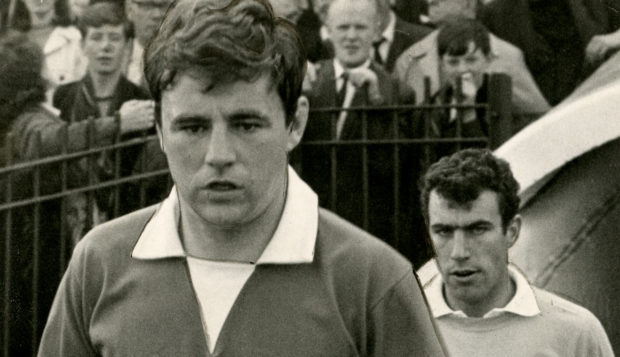
When Benny Rooney signed for Celtic in 1959, little did he know that one day he would be on the pitch with the first British team to win the European Cup.
He would have been even more surprised to learn that he would be on the opposition.
A team-mate at school of fellow Celtic signings Bobby Murdoch and John Cushley, Rooney had high hopes of a career in the Hoops.
His dad, Bob, was already the club physiotherapist – back in the days when they were known simply as ‘the trainer’, and another aspiring youngster, Billy McNeill, was to become a life-long pal.
But it didn’t work out for Benny, as he recalls.
“The club hadn’t been enjoying a lot of success, but while I was at Celtic Park, there were signs that something big was just around the corner.
“Eight of the guys who would become the Lisbon Lions were around at the same time as me, so competition for places was intense.
“As was the way at the time, I was farmed out to the juniors, first Cambuslang Rangers, then Petershill. I was also loaned to Dumbarton, and actually made my senior debut with them in the old Second Division.
“It became clear to me, however, that I wasn’t going to break through at Celtic, and in 1963, when I was 20, I was freed and joined Dundee United.
“I was playing up front, and got a few first-team games, but not enough. And after asking away more than once, I was transferred to St Johnstone for £3,500 in March, 1966.
“I moved back into defence, which seemed to suit me – except when my old mates paid a visit.”
Indeed. This Friday marks the anniversary of the day the final piece of Jock Stein’s Europe-conquering jigsaw was put in place, when he signed Willie Wallace from Hearts for £35,000.
It would be a few weeks before the team that would become the Lisbon Lions played together for the first time.
But on January 14, 1967, they did – and Benny was in the opposition and his dad in the visitors’ dugout.
“That was a bit ironic,” he admits. “I had kept in touch with a lot of the lads and my wife, Marion, was very friendly with big Billy’s wife, Liz.
“And because of my dad’s connection, I was regularly around Celtic socially.
“They were some team, of course, but we weren’t bad, either.
“Willie Ormond was a great manager. He had an excellent tactical brain but also gave his players their head on the pitch. He would set us up as a 4-2-4, then send us out, and let us work it out for ourselves if it wasn’t going to plan.
“That day against Celtic, it was going pretty well for an hour. But then Jimmy Johnstone popped up with a double, and Stevie Chalmers and Bobby Lennox – who’d all been on Celtic’s books while I was there – also scored for a 4-0 win.
“They did that, and worse, to a lot of teams that season.”
After eight years in Perth, Benny returned to Glasgow and joined Partick Thistle. Then in 1976, his football career took a significant twist when he became player/manager of Morton.
“I’d always fancied giving management a go, and Hal Stewart gave me that chance at Cappielow,” Benny continues.
“I achieved a fair bit of success, getting the club to the top of the Premier League at one stage, and to Scottish and League Cup semi-finals, but we were never quite able to win something.
“Andy Ritchie, who I signed from Celtic, was Player of the Year in 1979. And we had other great talents such as Neil Orr and Joe McLaughlin.
“The latter two were sold for big-money, however – Neil to West Ham, Joe to Chelsea – and things were never quite the same after that.”
In 1983, Benny moved on from Morton, and had spells as boss at Albion Rovers and Partick Thistle – before he ended up back at Celtic Park.
“Big Billy invited me to look after the club’s youth team, but when he made way for Liam Brady, my time at Celtic was up – again.”
Benny became a publican and ran the Queen’s Park Cafe on Glasgow’s Victoria Road for a number of years. Now 76, he’s enjoying retirement and watching the progress of his actor son, Kevin.

Enjoy the convenience of having The Sunday Post delivered as a digital ePaper straight to your smartphone, tablet or computer.
Subscribe for only £5.49 a month and enjoy all the benefits of the printed paper as a digital replica.
Subscribe